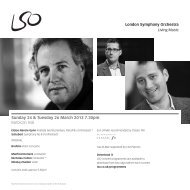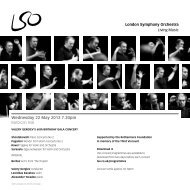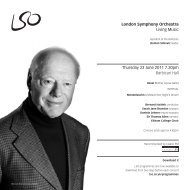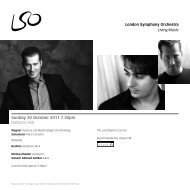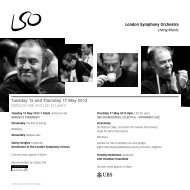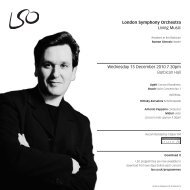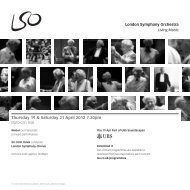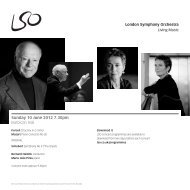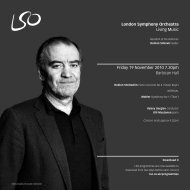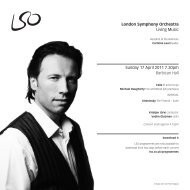1 April programme PDF - London Symphony Orchestra
1 April programme PDF - London Symphony Orchestra
1 April programme PDF - London Symphony Orchestra
Create successful ePaper yourself
Turn your PDF publications into a flip-book with our unique Google optimized e-Paper software.
little birds, and woodsy smells. No one knows the god Dionysus,<br />
the great Pan. There now! You have a sort of <strong>programme</strong> – that is,<br />
an example of how I make music. Everywhere and always it is only<br />
the voice of nature!’.<br />
As to that ‘<strong>programme</strong>’, Mahler was prepared to be more specific.<br />
He described the symphony’s six movements as follows:<br />
Summer marches in<br />
What the flowers of the meadow tell me<br />
What the animals of the forest tell me<br />
What night tells me (mankind)<br />
What the morning bells tell me (the angels)<br />
What love tells me.<br />
A plan emerges, in which each movement seems to aspire higher<br />
than the one before it: the awakening of elemental nature leads<br />
ultimately to transcendent love. But around the time of the Third<br />
<strong>Symphony</strong> Mahler seems to have lost faith in titles and literary<br />
<strong>programme</strong>s. Let the music speak for itself – or in the words of<br />
the Bible, ‘He that hath an ear, let him hear’. This undoubtedly made<br />
it harder for earlier audiences to grasp the Third <strong>Symphony</strong>’s<br />
meaning, but modern listeners may be thankful for the freedom<br />
Mahler gives them. After all, the music is vividly suggestive. If we<br />
can forget old-fashioned notions of what a symphony ‘should’ be,<br />
and set our minds free to explore its imaginative riches, then the<br />
Third <strong>Symphony</strong> can explain itself with a logic that is part musical,<br />
part dreamlike, but always compelling.<br />
Nevertheless, some preparation is needed for the symphony’s<br />
extraordinary proportions. The first movement is vast: around 35<br />
to 40 minutes in most performances – longer than the next four<br />
movements put together. Attempt to make sense of its structure<br />
along traditional formal lines and you will soon get lost. In essence<br />
it alternates three kinds of music: the dark, primordial sounds of the<br />
opening (described by Mahler as ‘Pan awakes’), pastoral sounds<br />
(murmurous wind and string trills, woodwind birdcalls), and gaudy<br />
military march music (brass fanfares, dotted rhythms and plenty<br />
of percussion). Eventually it is the latter music which dominates<br />
‘summer marches in’. The ‘flowers of the meadow’ minuet that<br />
follows is on a much more intimate scale, with hints of folk music,<br />
delicately scored. The naïve exuberance of the ‘animals of the forest’<br />
third movement is twice interrupted by solos from a distant post-horn,<br />
sounding magically through hushed high strings – a nostalgic memory,<br />
or perhaps an evocation of primal innocence. Near the end of this<br />
movement comes a ferocious fortissimo outburst for almost the<br />
whole orchestra. Pan is revealed again.<br />
Mankind’s struggle to make sense of the world, its joy and grief,<br />
is the subject of the Nietzsche setting, almost all of it delivered<br />
in an awe-struck pianissimo. Then the sound of bells (literally and<br />
impersonated by the boys’ choir) introduces the angels’ song of<br />
childlike rapture at God’s forgiveness of the apostle Peter. Finally<br />
comes the symphony’s true slow movement. An intense hymn-like<br />
theme for strings alternates with music that seems more troubled,<br />
searching. Sounds from earlier in the symphony return, then the<br />
hymn builds to a radiant major-key climax. Mahler revealed to Anna<br />
von Mildenburg that he had in mind a motto for this movement:<br />
‘Father, see these wounds of mine! Let no creatures of yours be lost!’<br />
(Vater, sieh an die Wunden mein! Kein Wesen lass verloren sein!).<br />
His next words probably say more than any about the message<br />
he embedded in his Third <strong>Symphony</strong>. ‘I could almost call this [the<br />
finale] ‘What God tells me’. And truly, in the sense that God can<br />
only be understood as love. And so my work begins as a musical<br />
poem embracing all stages of development in a step-wise ascent.<br />
It begins with an inanimate nature and ascends to the love of God’.<br />
Programme Note © Stephen Johnson<br />
Stephen Johnson is the author of Bruckner Remembered (Faber). He<br />
also contributes regularly to the BBC Music Magazine, and broadcasts<br />
for BBC Radio 3 (Discovering Music), Radio 4 and the World Service.<br />
Programme Notes<br />
5



